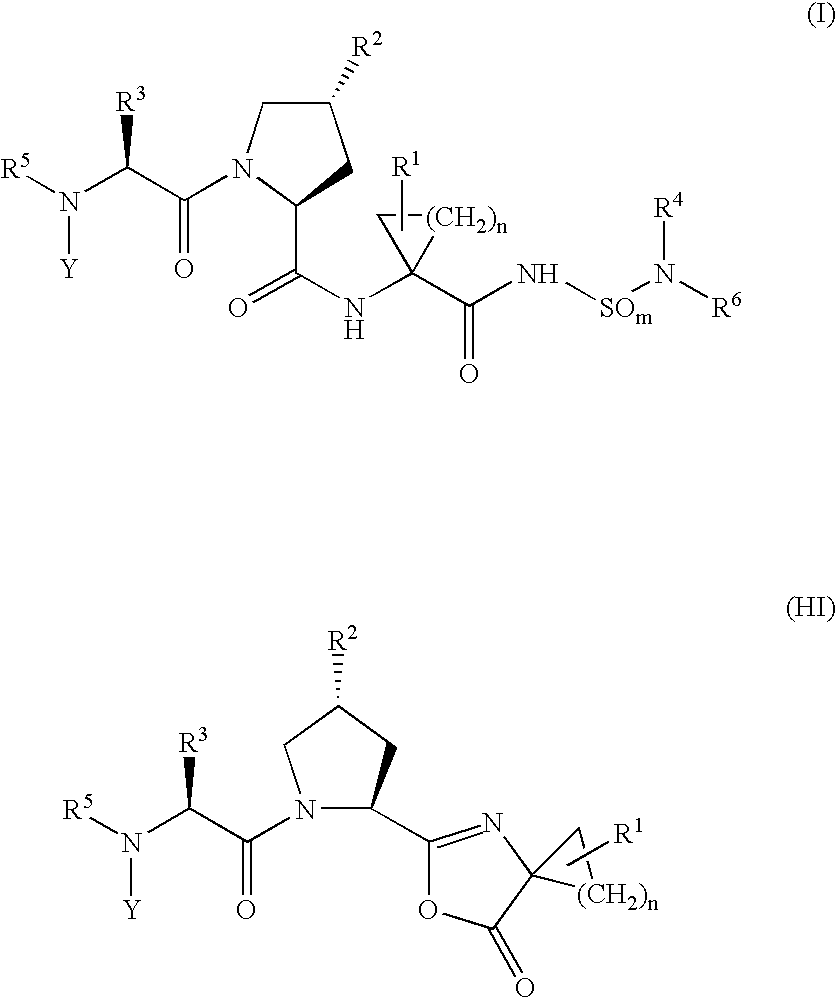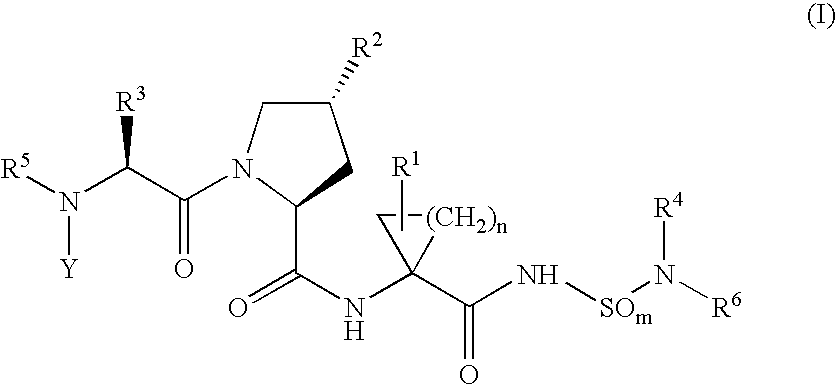Hepatitis c inhibitor peptide analogs
- Summary
- Abstract
- Description
- Claims
- Application Information
AI Technical Summary
Benefits of technology
Problems solved by technology
Method used
Image
Examples
example 1a
SYNTHESIS OF P3 CARBAMATE 1A
[0562]
[0563] The P3 carbamate fragment 1a was prepared as described in WO 03 / 064416. THF (350 mL) was added to a flask containing carbonic acid cyclopentyl ester 2,5-dioxo-pyrrolidin-1-yl ester (9.00 g; 39.6 mmol) and tert-butyl glycine (6.24 g; 47.5 mmol) resulting in a suspension. Distilled water (100 mL) was added with vigorous stirring. A small amount of solid remained undissolved. Triethylamine (16.6 mL; 119 mmol) was then added resulting in a homogenous solution which was stirred at RT. After 2.5 h, the THF was evaporated and the aqueous residue diluted with water (100 mL). The reaction was rendered basic by the addition of 1 N NaOH (25 mL-final pH>10). The solution was washed with EtOAc (2×200 mL) and the aqueous phase acidified with 1 N HCl (ca. 70 mL; final pH4) and evaporated to give carbamate 1a as a white solid (8.68 g).
[0564] It will be apparent to one skilled in the art that analogous P3 carbamate fragments in which the cyclopentyloxycarbo...
example 1b
SYNTHESIS OF P3 UREA FRAGMENT 1B
[0565]
[0566] A solution of te / f-butyl glycine benzyl ester hydrochloride salt (2.55 g; 9.89 mmol) in THF (20 mL) and pyridine (2.0 mL; 24.73 mmol) was cooled to 0° C. Phenyl chloroformate (1.30 mL; 10.19 mmol) was added dropwise to the cooled solution. The resulting suspension was stirred for 5 min at 0° C., then at RT. for 1.5 h. The reaction mixture was diluted with EtOAc, washed with 10% citric acid (2×) water (2×) saturated NaHCO3 (2×), water (2×) and brine (1×), dried (MgSO4), filtered and evaporated to obtain the crude compound as a nearly colorless oil (3.73 g; >100%; assume 9.89 mmol). The crude product (1.01 g; 2.97 mmol) was dissolved in DMSO (6.5 mL) and cyclopentylamine was added dropwise. The reaction mixture was stirred at RT. for 45 min and then diluted with EtOAc. The organic phase was washed with 10% citric acid (2×) water (2×) saturated NaHCO3 (2×), water (2×) and brine (1×), dried (MgSO4), filtered and evaporated to give the crude ...
example 2a
SYNTHESIS OF P2 BULIDING BLOCK 2-METHYL-3-METHOXYANILINE (2A2)
[0573]
[0574] To a solution of 2-methyl-3-nitro anisole which is commercially available (2a1) (5.1 g 30.33 mmol; requires ˜30 min. to dissolve) in absolute ethanol (85 mL) was added 10% Pd / C catalyst (500 mg). The solution was hydrogenated under a hydrogen filled balloon at atmospheric pressure and room temperature for 19 hrs. The reaction mixture was filtered through a Celite pad, rinsed and evaporated to dryness to obtain the compound 2a2 as a deep mauve oil (4.1 g; 29.81 mmol; 98% yield). MS 137 (MH)+. Reverse Phase HPLC Homogeneity @ 220 nm (0.06% TFA;CH3CN;H2O):99%.
PUM
| Property | Measurement | Unit |
|---|---|---|
| Force | aaaaa | aaaaa |
| Fraction | aaaaa | aaaaa |
| Fraction | aaaaa | aaaaa |
Abstract
Description
Claims
Application Information
 Login to View More
Login to View More - R&D
- Intellectual Property
- Life Sciences
- Materials
- Tech Scout
- Unparalleled Data Quality
- Higher Quality Content
- 60% Fewer Hallucinations
Browse by: Latest US Patents, China's latest patents, Technical Efficacy Thesaurus, Application Domain, Technology Topic, Popular Technical Reports.
© 2025 PatSnap. All rights reserved.Legal|Privacy policy|Modern Slavery Act Transparency Statement|Sitemap|About US| Contact US: help@patsnap.com



